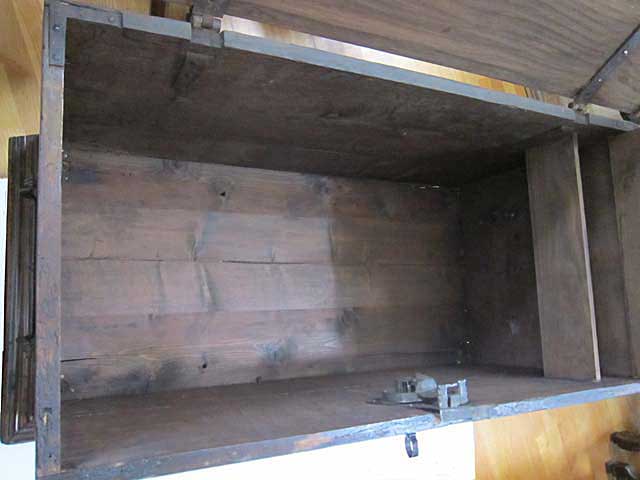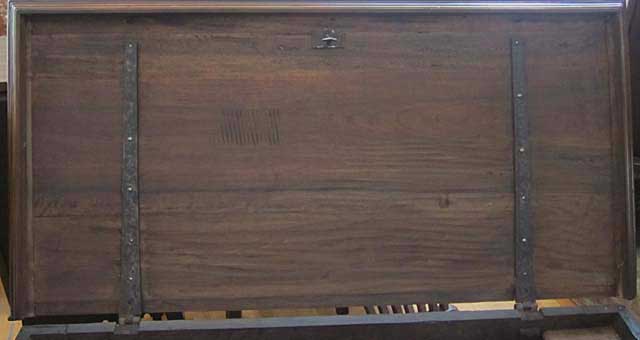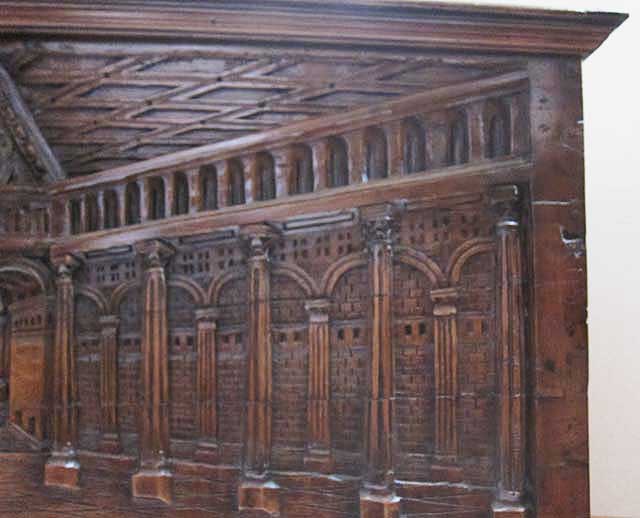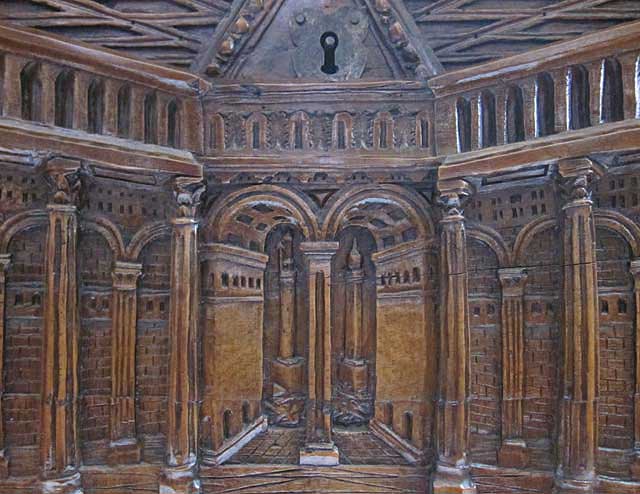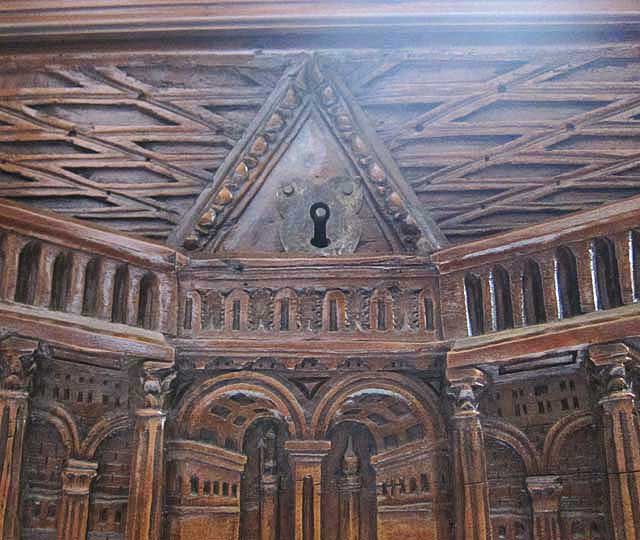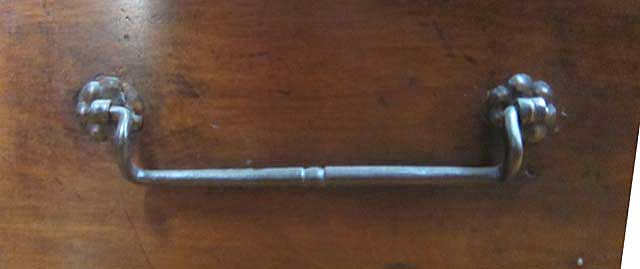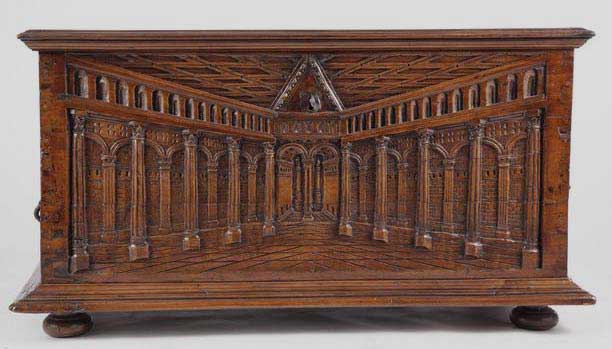
When we located this chest in France we knew it was unlike anything we had ever seen. But not until arriving in Texas, where we could examine it more closely, did this magnificent piece began to reveal some of its secrets while inspiring a quest to learn more (involving multiple countries and languages). For example, it is evident that the chest was made by hand from what is now very old walnut. The marks of the adz remain visible on the back from a time before mechanical saws made swift work of cutting wood. The front panel is dominated by a detailed carving with a luscious patina. It, and the back panel chiseled out by hand, were attached to the sides with dove-tail joinery, additional indicators of a very old piece. The top is newer, probably late 19th or early 20th century. The moulding at the bottom and the bun feet (pieds boule) are also likely not contemporaneous with the rest of the piece although the bun feet give it an especially French flavor.
It is the front panel that not only commands attention but invites close examination of a scene based on linear perspective with a vanishing point in the middle. We are drawn to it and drawn into it, as if walking through the center of a large building with colonnades on the sides and a coffered ceiling, heading to an opening in the distance where two free-standing columns are visible.
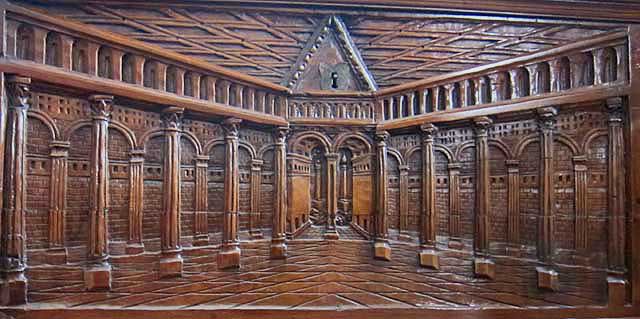
A complete illusion is created in exquisite detail to fool us and to create a realistic feeling as our eyes are led, inescapably, to the vanishing point behind a column at the center. It compels us to examine the details while appreciating the overall perspective and feeling deposited into a different place and time. The anonymous maker of this chest was not the first to be captivated by the possibility of carving a vast trompe-l'œil edifice in walnut but in doing so he evokes some of the world's most enduring works of art.
When admiring this chest, it is impossible not to think of how it conjures the spirit of rediscovery in Italy during what is now called the Renaissance, with its sense of a rebirth of critical knowledge lost since ancient times. This includes how to reproduce three-dimensional images on a two-dimensional surface using mathematical calculations. We have Filippo Brunelleschi (1377-1446) to thank for his efforts in rediscovering and harnessing the expressive power of linear perspective. Its principles for creating a realistic sense of space were disseminated by two other innovators — the architect Leon Battista Alberti (1404-1472) in his De Pictura and the painter Piero della Francesca (1415-1492) in his De Prospectiva Pingendi. They all changed the way the world was represented in paintings, and in furniture, forever. For those who mastered the technique there were lucrative commissions and the opportunity to display sophistication and virtuosity for admirers in the 15th century and beyond.
For modern viewers, it may be a challenge to imagine how revolutionary the solving of the riddle of perspective was for artists vexed by it since the Dark Ages. It is no wonder that gold leaf or crowds of saints and angels were used as background filler for illustrating religious scenes instead of depicting buildings that seemed off-kilter and so jarring to the viewer that the spiritual message was diminished. The following paintings by the Sienese master, Duccio di Buoninsegna (1255-1319), reflect the difficulties in depicting space and the solutions employed in a pre-Renaissance environment.

The Calling of the Apostles Peter and Andrew by Duccio (National Gallery, Washington, DC)

Detail of the Maestà by Duccio (Museo dell'Opera del Duomo, Siena)
Linear perspective relies on the relationship of objects and the drawing of lines leading to a vanishing point (typically in the center) of a painting such that objects appear to recede as they would in a three-dimensional world. With it, what an artist could represent equated with what we could see with our own eyes. Not only symmetrical and balanced, it promoted contemplation, introspection, and a sense of well-being.
For example, the following painting of Jesus healing a blind man, by Duccio, was done before the rediscovery of linear perspective. It includes buildings but they just don't seem to line up correctly to create a reliable sense of space. El Greco (1541-1614) painted the same subject, but is clearly the master of linear perspective in how he has rendered the buildings on the left side of the painting and the paving stones receding to the vanishing point.

Jesus Healing the Blind by Duccio di Buoninsegna (National Gallery, London)
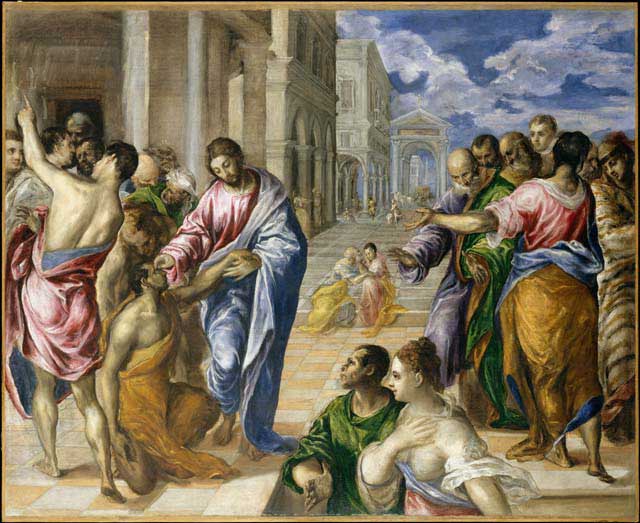
Jesus Healing the Blind by El Greco (Metropolitan Museum, New York)
Employing linear perspective, artisans were off to the races to create frescoes, bronze doors, tapestries, ceramics, furniture, and wood paneling asserting their mastery of the technique. It is no wonder that patrons loved it too. They could imagine themselves drawn into a world beyond their daily existence, one where they interacted with the figures in a painting or wandered into grand buildings and sweeping plazas. And they were willing to fork over large sums of money to become the owners of items displaying this revolutionary technique.
One of the earliest adopters of linear perspective was the painter Paolo Uccello (1397-1475), whose The Hunt in the Forest, hangs in the Ashmolean Museum in Oxford. While researching this Chest 5227, we happened to see the Point of Vanishing, an episode from the Inspector Lewis detective series on British television in which Uccello's masterpiece plays a prominent role. While there are no buildings in Uccello's painting, the trees of the forest provide the framework to guide our eye to the vanishing point where the quarry, the deer, is seen in the distance.
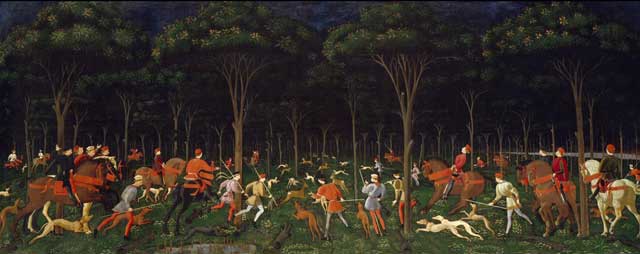
Rather than a forest, the use of linear perspective in depicting urban settings gave rise to a new genre of art in the late 15th century know as la città ideale or the ideal city. It was the subject of an exhibit organized by the Museo Nazionale delle Marche at the Ducal Palace in Urbino in 2012. Speculation is that several artists developed the genre while working for Duke Federico da Montefeltro (1422-1482), a wealthy and successful military commander and a visionary when it came to promoting culture in his little corner of Italy. His architect, Luciano Laurana (1420-1479), created the courtyard for the ducal palace in a Renaissance style featuring columns with Corinthian capitals, pilasters, arcades, arches, and small windows. It is tempting to speculate that the creator of our chest knew the courtyard and sought to capture a sense of it, to be admired in a more portable form, carved out of wood. The resemblance is uncanny.
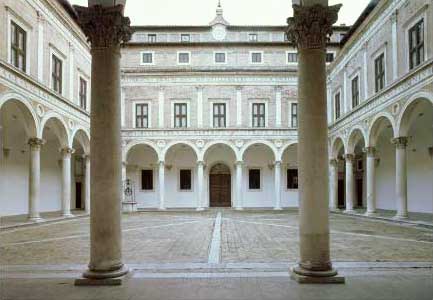
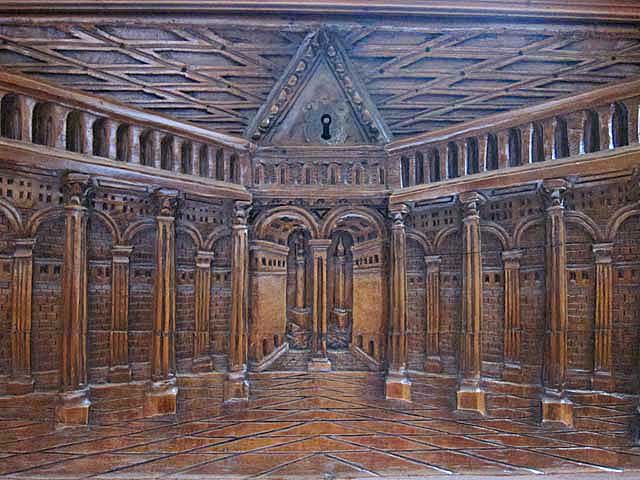
Speculation is that Laurana was the painter of one or more of the following three most famous paintings of ideal cities, shown together, and the focus of the exhibition. The top one is from the collection at the Ducal Palace. The middle one is from the Walters Art Museum in Baltimore. The bottom one is from the Gemäldegalerie in Berlin (but proved too fragile to make the trip to Urbino in 2012).
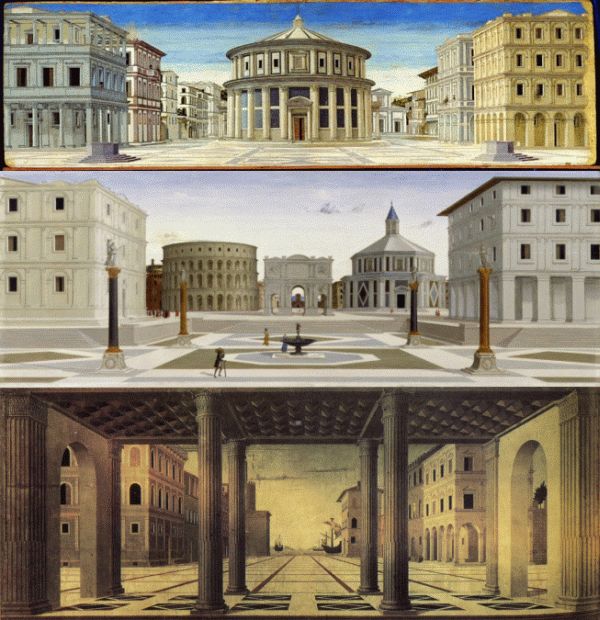
The paintings continue to intrigue viewers for the beauty of the architecture evoking the artists' enthusiasm for the revival of designs from ancient Rome. Compared to the tangle of narrow medieval streets found throughout the peninsula (including today), artists envisioned a more modern, idealized world of buildings with civic importance framing large piazzas. Everything looks clean and well-maintained. People are nowhere to be found (the figures in the middle painting were apparently added later). It is as if some neutron bomb was detonated, vaporizing the inhabitants but leaving the buildings spotless and intact! The emphasis is on mastery of linear perspective, including details such as the paving stones and the facades of buildings, both of which steer our eyes to the central vanishing point. Could these works be expressing the superiority of science, i.e., the mathematical calculations necessary to make these paintings so convincing, as the way forward in achieving an ideal world represented by these cities? Whatever their objective, they are triumphs of the imagination.
Around the same time, masters of intarsia or marquetry — involving designs with pieces of wood inlaid as a mosaic would be with stone — also embraced linear perspective. They used various types of woods to achieve a progression of colors and the gradual fading from the near space to the vanishing point. The maestri de prospettiva built cupboards for the private studies at palaces in Urbino and Gubbio for Duke Federico da Montefeltro based on designs by Antonio Manetti Ciaccheri enshrined in the Sacristy of Santa Maria del Fiore in Florence. As with the paintings, the scenes were devoid of people, focused instead on the richness of the architecture, such as this one from Urbino.
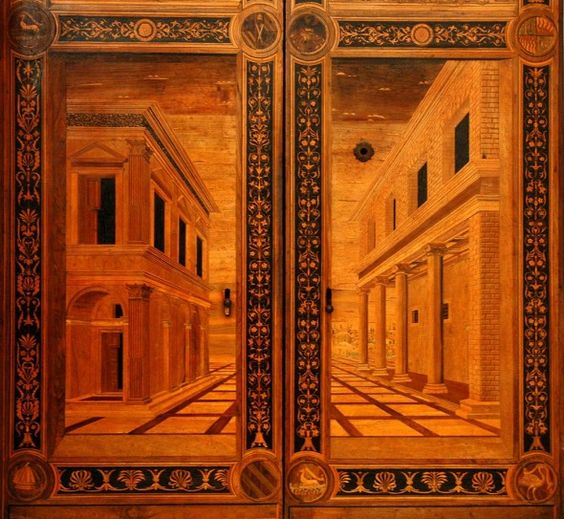
These specialized artists, the intarsiatori, reveled not only in their mastery of linear perspective but in creating trompe-l'œil effects to dazzle the viewer, such as the technique of making the ideal city appear to be a view from an open window, as in this fragment by Pier Antonio degli Abbati from the Museo Horne in Florence. The shutter (complete with hinges) appears to be ajar as our gaze is directed through the window to the distant cityscape. In the foreground, on the window sill, is the foreshortened image of a lute in case the beauty of the city might spur an impromptu saltarello.
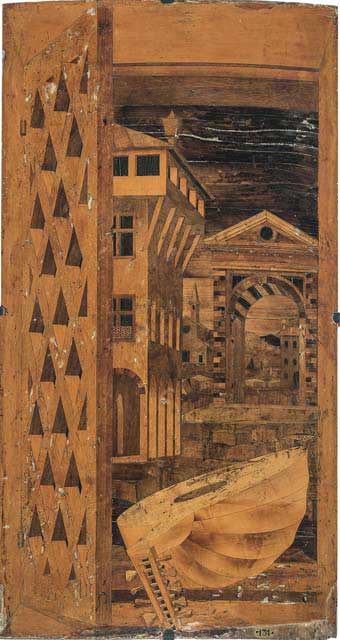
Which came first — the intarsia versions of ideal cities or the painted ones? This remains the subject of scholarly debate. However, the ideal city in the form of furniture continued as a subject for an additional century around northern Italy, primarily in the choir stalls of major churches and in chests and cabinets used in people's homes.
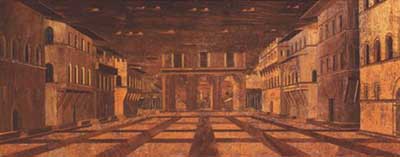
Front panel of chest (Palazzo Pitti, Florence)
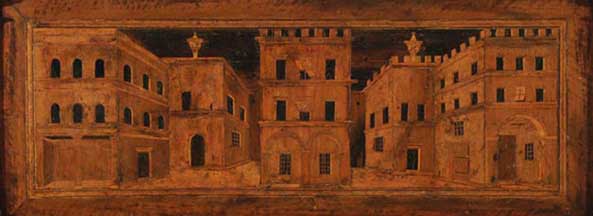
Front panel of chest (Ducal Palace, Urbino)
As with any fashion, interest in intarsia came and went. It was eventually superseded by pietra dura, a similar technique based on marble but with highly colorful and expensive inlays beyond the scope of what woods could offer.
In addition to intarsia, woodworkers used carvings in bas relief to create scenes of deep perspective within an architectural framework. Such an approach was popular in Northern Italy and coexisted with intarsia for around a century, especially in the work of a transplanted Rouenais, Richard Taurigny, who brought with him from France to Italy some of the design elements developed by Rosso Fiorentino and other Italian artists working for King François I at Fontainebleau. Taurigny's work for the Basilica of Santa Giustina in Padua is highly sophisticated and intricately carved. The figures in the foreground seem ready to move forward into our space while the complex scene behind them involves archways based on linear perspective. What is distinctive, and a break from the tradition of idealized architecture in intarsia, is that the arches recede at an angle toward the side rather than straight back.
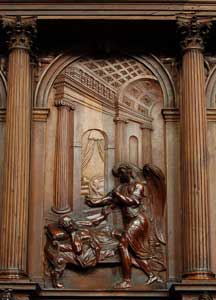
Taurigny's presence in Italy is not the only example of cross-pollination of French and Italian design during the height of the Renaissance in the 16th century. The great French architect, Philibert de L'Orme (1514-1570) was born in Lyon, the son of a master stone mason and builder. As a young man, he went to Rome to study architecture and not only brought a wealth of knowledge back to his hometown but also wrote a famous treatise on architecture. He was involved in a number of projects, especially in the Loire Valley, for King Henri II and his mistress, Diane de Poitiers and later for Henri's widow, Catherine de' Medici. These included the long gallery over the River Cher at the Chateau of Chenonceau. Philibert's knowledge of Roman architecture and his publication in France influenced furniture makers seeking to achieve a similar focus on designs evoking ancient Rome.
Contemporaneously, Italian cabinet makers had set up workshops in Lyon and were celebrated in the 16th century (the period known as the Second Renaissance in France) for their designs involving architectural perspective. Their output was focused on cabinets but also included chests and chairs, most often with a central barrel vault receding away from the viewer at an angle, similar to the technique favored by Taurigny. Perhaps this was seen as the next level of sophistication in rendering three-dimensional space on two-dimensional surfaces and detaching this style from what may have been viewed as the more old-fashioned intarsia where perspective receded straight back to the center of the design.
The following chest (apparently once the upper part of a dressoir cabinet from the collection of the Museum of the Renaissance in Ecouen, France epitomizes the French embrace of designs involving linear perspective, including perspective receding at an angle to a hidden vanishing point. That it is found in the Medici Room evokes the possibility that the Queen Mother, Catherine de' Medici, could have admired this style of design created by Italian craftsmen and even acquired such a chest during her famous shopping spree in Lyon in May of 1564.
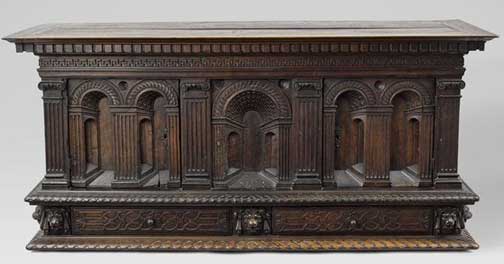
As the esteemed Jacqueline Boccador stated in her groundbreaking book (reference, below), the high-backed chair, below, from a private collection, is one of the true masterpieces of "furniture architecture" in the Second Renaissance in France. She highlights the striking nature of the panels on the lower or chest section of the chair and how they represent a complete break with ornamentation such as plis-de-serviette, tracery, and arabesques popular in earlier styles of furniture. She acknowledges that its astounding quality and virtuosity signal that this is the work of a great artist and one with a devotion to classic architecture. As to its origins, she speculates that it was a commission executed for a chateau in the Loire Valley or the region including Paris, somewhere between 1530 and 1550.
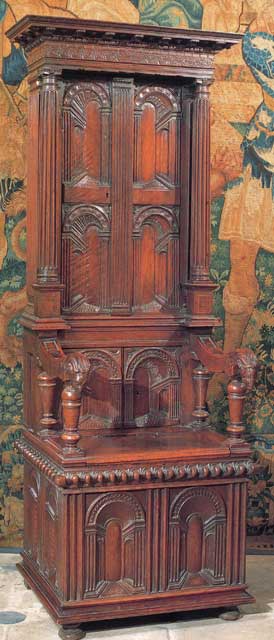
What strikes us is the similarity of the panels on the lower part of Boccador's chair to the central panel of the chest from Ecouen, pictured above. Both are based on the straight-on view of perspective with a vanishing point in the center. The panels on the upper back of the chair employ the alternative technique wherein the scene recedes at an angle with the vanishing points off to the sides, invisible but somewhere near the center of the chair. The same can be said of the outermost panels on each side of the front of the chest. The composition of these panels, based on a central arch but with an elevated doorway to one side, is strikingly similar in both pieces.

Panel from high-backed chair

Panel from Ecouen chest
With an understanding of French and Italian designs based on linear perspective in the Renaissance, whether in paintings, intarsia, or furniture, we can examine our own chest in more detail and with a greater appreciation of its extraordinary artistry.
First of all, the chest is large — at just over four feet wide and over two-feet high (including the bun feet). The sculpted panel on the front fills almost the entire space available. Secondly, the front is comprised of one panel, not several as on French chests of the Second Renaissance. Rather, it is one scene of linear perspective with a vanishing point at the center, more reminiscent of Italian chests of the 15th century whose front panels are intarsia (such as the ones from the Pitti Palace and the Ducal Palace shown above). But ours is not intarsia, it is sculpture in bas relief, a technique requiring far more skill and virtuosity.
We have isolated certain aspects that lead us to think that the front panel was created in or inspired by the Veneto region of Northern Italy including Venice. For example, in the center are crenellations with a design of merlon that is typical of Venice and reflecting the Moorish influence on the architecture of La Serenissima.
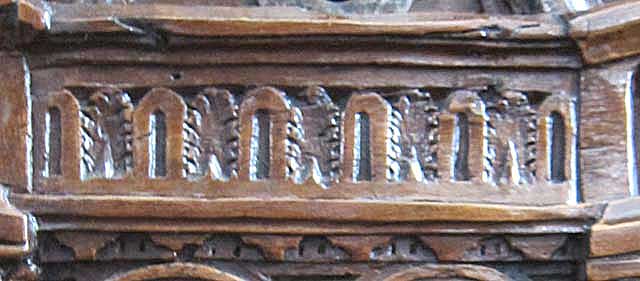
Looking for inspiration beyond the Veneto, there are the repeating, rounded arches at the outer sides of the portico, reminiscent of the interior of the Basilica of San Lorenzo in Florence. These also remind us of a church farther north, the rounded arches and coffered barrel vault of the Basilica of Sant'Andrea in Mantua. It is one of the only buildings attributable to Leon Battista Alberti, the author of the treatise on linear perspective. There are many potential sources of inspiration for the sculptor of this chest, both in bricks and mortar and in the books of architectural engravings, leading us to conclude that, as in the case of the ideal city paintings, no existing edifice is involved. Rather, it is the product of a fertile imagination.
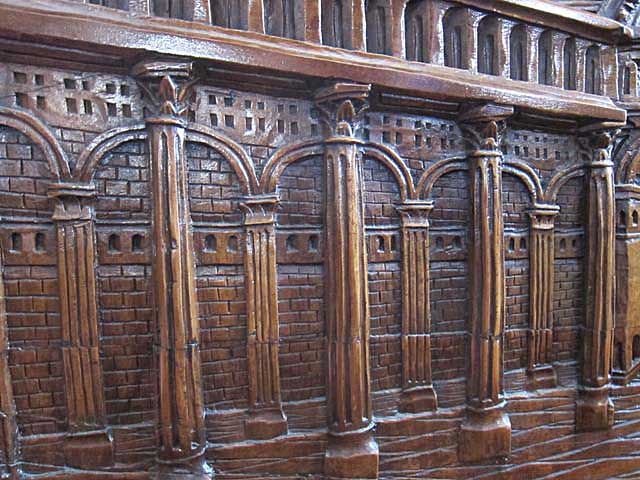
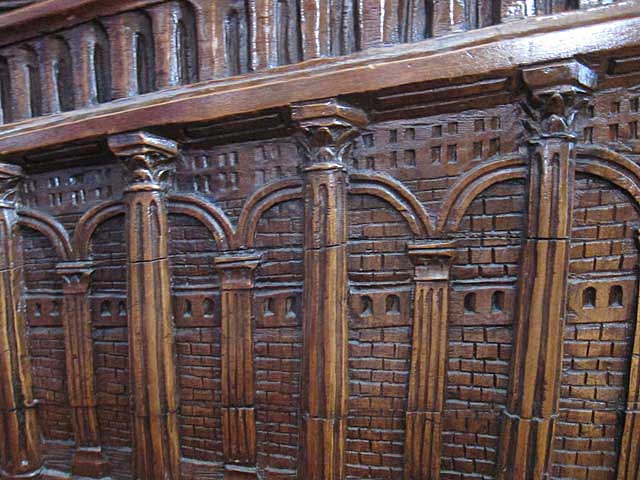
Our gaze is drawn inexorably to the center of the chest where the vanishing point is found. The arches of the colonnades as well as the pavement tiles and the coffered ceiling drive our attention inward toward the area below the lock. The colonnades consist of fluted Corinthian columns, five on each side.

There is almost a rusticity to the technique in which some of the details on our chest are approximate, such as the capitals of the Corinthian columns supporting a gallery on either side. Just below the galleries are two rows of what appear to be tiny windows. A similar, single row is repeated midway up the outermost walls. Those walls appear to be made of brick, an unusual choice for representing a surface in a depiction of an ideal city in paintings. However, bricks were skillfully depicted in the intarsia panels at the Ducal Palace in Urbino (and referenced earlier). The carving of so many tiny bricks on this chest, all shaped in adherence to the demands for representing linear perspective, demonstrates the mastery attained by this chest's creator.
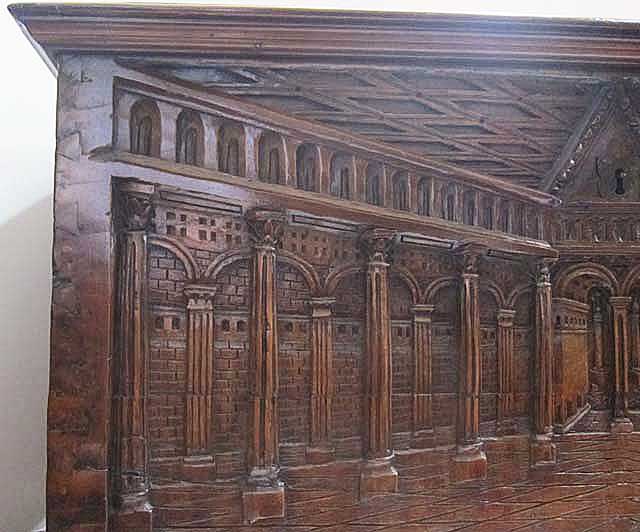
As we get to the center of the panel, where the corridors open out onto the square, there is a double passage with vaulted ceilings into which coffering has been carved. The focal point of the central design is a pair of columns, one seen through each of the porticoes. The column on the left has three extensions on the top, of different lengths with caps on them looking like three little stovepipes. On the right, the column is topped by a figure resembling a spout or a turban.
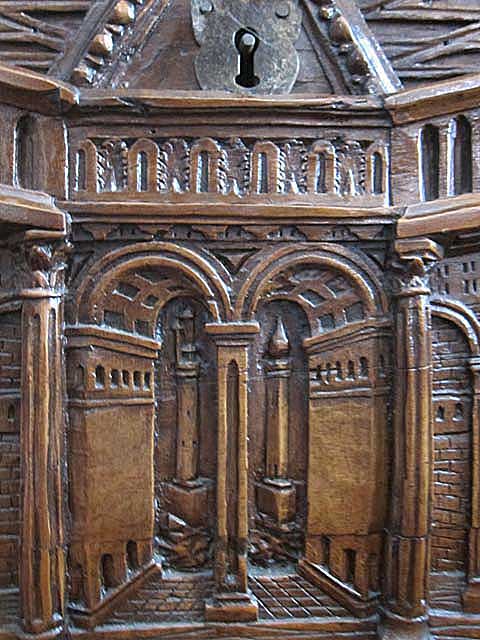
At first, we thought that perhaps this was another allusion to Venice where two columns, commemorating Saint Mark (the winged lion) and Saint Theodore (vanquishing a crocodile), are seen on the piazzetta near the entrance to Saint Mark's Square from the harbor. On the left, below, is a view of the area from the Museo Correr and on the right is a painting by Lazarro Bastiani (1429-1512) that hangs in that museum. Both include the facades of the buildings on the plaza, receding toward a vanishing point in the harbor beyond the columns.
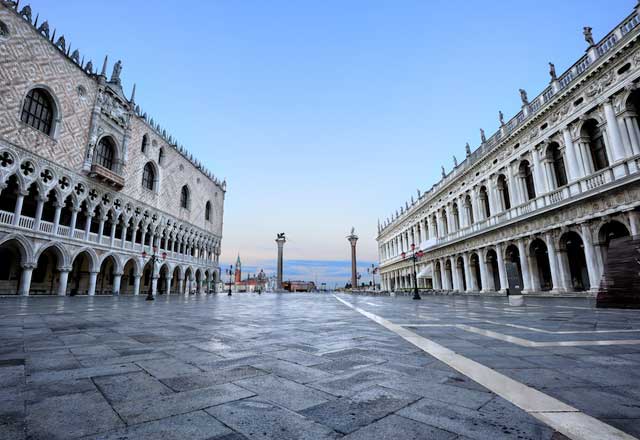
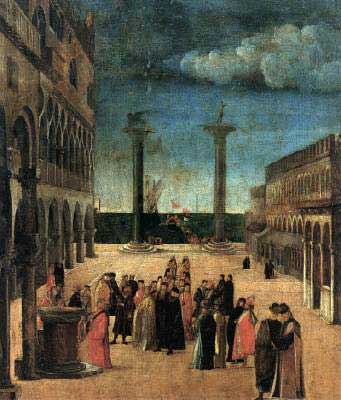
Unfortunately for our theories revolving around Venice, the tops of the columns on the chest bear no resemblance to those in Saint Mark's Square. Nor have we yet found them elsewhere in Italy, which is intriguing because each has a distinctive shape that could be significant.
Although not the solution to the mystery, another Venetian connection is tantalizing. Vittorio Carpaccio (1425-1526) painted nine canvases for the Scuola di Sant’Orsola depicting the life of Saint Ursula (now at the Gallerie dell'Accademia). The saint is closely associated with Cologne, where there is a basilica dedicated to her, while there is no indication that she ever visited Venice. Nevertheless, Carpaccio filled his paintings with recognizable examples of Venetian architecture as well as figures decked out in finery fashionable there at the time. At the left is a colonnade that angles away from the viewer and leads the eye to where there is a free-standing column near the water's edge with a pennant hanging from it.
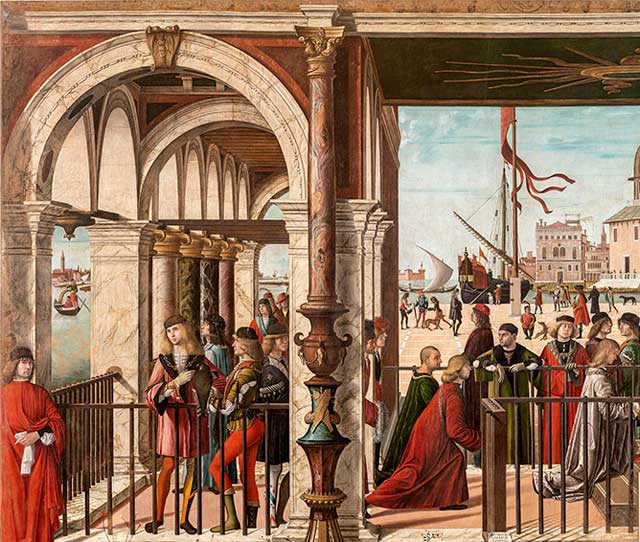
It is possible that the free-standing columns at the center of the chest were meant to be seen as arising from a body of water or a rocky shore, given the irregular shapes depicted below them. So the mystery of their identity continues along with the possibility that they are an idealized location.
Above the central scene with the twin porticoes is a triangular shape where the lock sits, albeit not exactly in the middle.
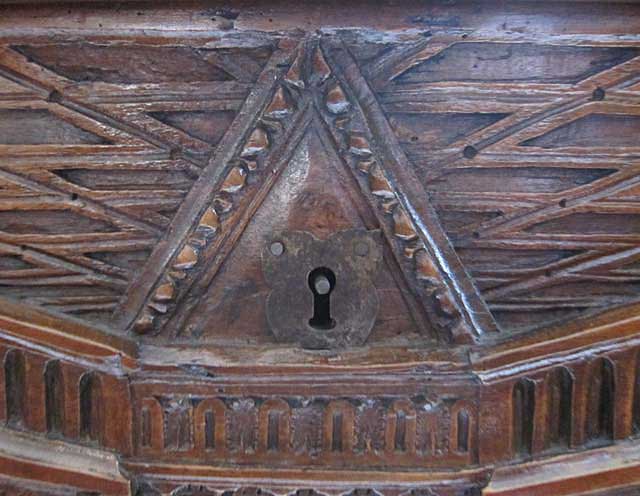
As the following photos reflect, the lock itself is massive when viewed from the interior of the chest just as the key is large and complex for opening the lock.
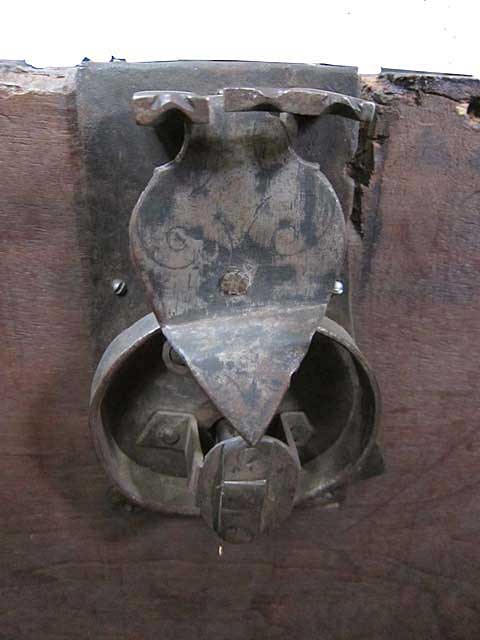
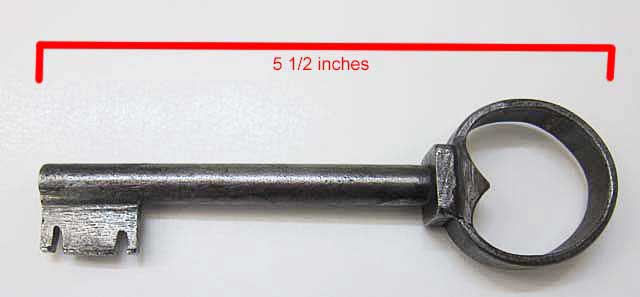
As mentioned above, we expect that the top of the chest is an addition from the late 19th century or early 20th century. The grain of the walnut is more pronounced and the patina less rich than that of the body of the chest.
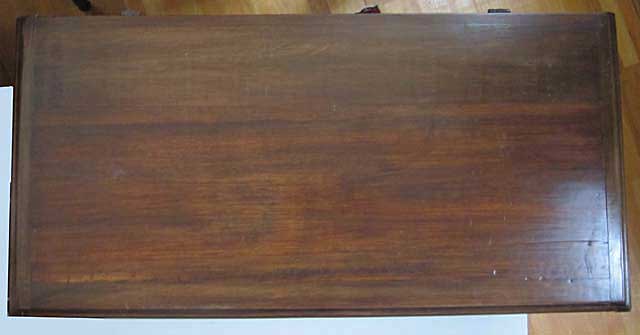
The hardware, including a massive hand-forged handle on each side, is very old.
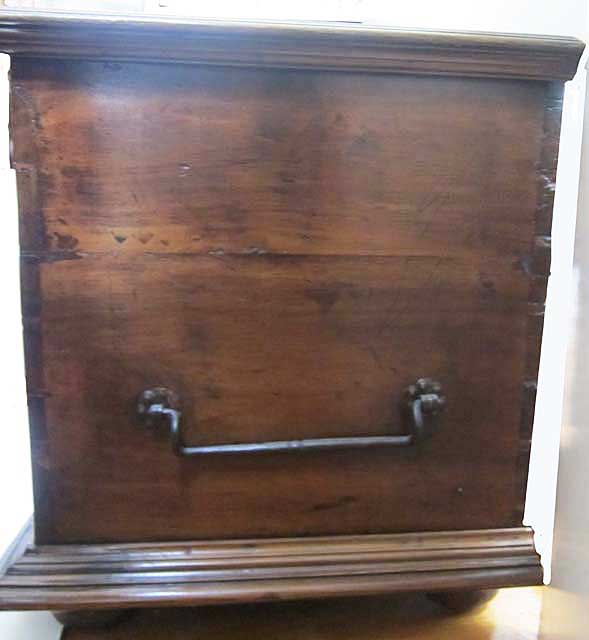
As the pictures of the chest reflect, there are some small cracks in the front panel. Given the age of the panel, and how many times the chest may have been moved and subjected to changes in humidity and temperature over the span of centuries, the presence of cracks is another indication of age. They do not impact the structural integrity of the chest. The most representative color, given the challenges of photographing dark furniture, is in the image at the top of this page.
For every secret this magnificent chest has given up, it seems another enigma arises. But they are all enthralling and have provided us with many hours of interesting research and opportunities for speculation. At the end of it all, we remain convinced that the front, back, and sides of the chest were created together. They most likely date from sometime between the 16th and 18th centuries in northern Italy or southeastern France. In crafting this intriguing chest, its creator has invited admirers down the centuries to examine it closely and to touch it admiringly. In a world before computer simulations and virtual journeys, he has wrought a unique universe that beckons and fascinates us.
Reference
Ader-Tajan, Collection Bruno Perrier Haute Epoque (Catalog for Sale at Auction on December 7, 1993 at the Hôtel Drouot, Paris); Allen, Joan, Choir Stalls in Venice and Northern Italy (Doctoral Thesis, University of Warwick, 2010); Antonucci Becherer, Joseph, Pietro Perugino (Grand Rapids Art Museum, 1997); Boccador, Jacqueline, Le Mobilier Français du Moyen Age à la Renaissance (Editions d'Art Monelle Hayot, Saint-Just-en-Chaussée, 1988); Carroll, Eugene A., Rosso Fiorentino — Paintings, Drawings, Prints, and Architecture, (On line from Vassar College, Poughkeepsie, 2016); Chastel, André, Discovering Intarsia (Franco Maria Ricci No. 26, 1987); Clark, Kenneth, Civilisation, (Harper & Rowe, New York, 1969); Costantino Fioratti, Helen, Il Mobile Italiano (Giunti Editore, Firenze-Milano, 2004); Duckworth, Emily J., Renaissance Intarsia, e-arthistory (2013); Lillie, Amanda, Building the Picture: Architecture in Italian Renaissance Painting (On-line publication of the National Gallery, London, 2014); O'Malley, Michelle, The Business of Art — Contracts and the Commissioning Process in Renaissance Italy (Yale University Press, New Haven, 2005); Raggio, Olga and Antoine M. Wilmering, The Liberal Arts Studiolo from the Ducal Palace at Gubbio (Metropolitan Museum of Art, 2004); Seta, Cesare de, The Urban Image: Real and Ideal (Franco Maria Ricci No. 26, 1987); Thirion, Jacques, Le Mobilier du Moyen Age et de la Renaissance en France (Editions Faton, Dijon, 1998)
Uses
This chest merits placement in a spot where it can be viewed both from a distance and up close, and preferably elevated. For a feeling of the Italian countryside, the perfect accompaniment would be to place our Tuscan Chairs 3301 on either side of the chest. Sharing a northern Italian heritage, they are portable enough to move when wishing to study the front of the chest and comfortable enough for extended contemplation. For a more formal setting, a pair of chairs such as Sgabelli 5190 would complement the science represented by the linear perspective of the chest with the art represented by the many Renaissance design elements visible on the chairs.
